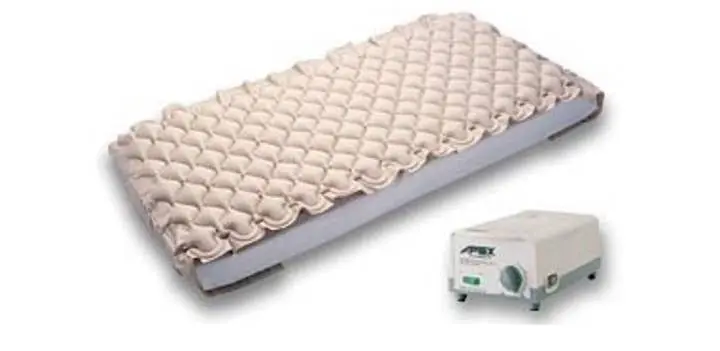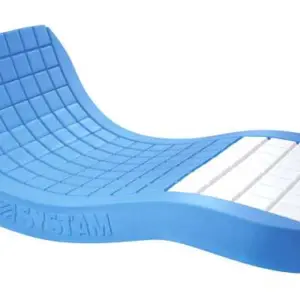Your cart is currently empty!

Anti-decubitus mattresses – reimbursement and application
Prophylaxis against decubitus ulcers is an important and ongoing measure for long-lying, paralyzed and immobile patients. The problem of bedsores can affect seniors, disabled adults and children. Preventing bedsores is one of the most important activities when caring for bedridden patients and those undergoing rehabilitation after accidents or surgery. One of the most important parts of this process is to get a mattress against bedsores, for which reimbursement is available.
Action of anti-decubitus mattresses
The main principles of proper decubitus ulcer prevention include relieving pressure points on the body, proper nutrition and hydration, observing body hygiene, checking and monitoring skin conditions, education and cooperation with the care team.
Following the rules and using the right accessories allows wounds to heal faster and prevents new sores and further conditions. The basic accessories necessary for the prevention of bedsores are special mattresses that effectively help the patient and caregivers. There is a reimbursement for the anti-decubitus mattress, so those who take care of a recumbent patient can apply for financial assistance for its purchase.
Odleżyny powodowane są długim uciskiem jednego miejsca i słabym przepływem krwi. Zbyt niskie dotlenienie tkanek wywołuje rany w okolicy łopatek, bioder, łokci i pięt. Użycie materaca, jako element profilaktyki, przeciwdziała pojawianiu się odleżyn poprzez wentylację i prawidłowe ukrwienie narażonych na odleżyny miejsc ciała. Materac przeciwodleżynowy zmniejsza ucisk tkanki miękkiej na kości, równomiernie go rozkłada poprzez zmianę punktów podparcia. Pomaga utrzymać skórę chorego w dobrej kondycji i zapobiega dalszym powikłaniom.
Before use, it is good to put a classic sheet on the mattress, but it must not be a thick material. The mattresses can be easily cleaned, stored and moved. It should always be remembered that their use is only one of the prevention and treatment measures, and simply having them does not exempt caregivers from regularly repositioning the person lying down and following the other preventive rules. The available reimbursement of the anti-decubitus mattress 2022 will make it easier for you to purchase the equipment and improve your action with the patient.
Zobacz wszystkie materace przeciwodleżynowe
Types and choice of bedsores mattress
The equipment provides relief to the patient and is an aid to the caregiver. There are two types of anti-decubitus mattresses – bubble and tubular. Both types are practical, durable and easy to use, but used in slightly different situations. The choice between the two depends on the patient’s condition, his weight and whether he is completely recumbent or gets up from time to time. In addition to mattresses, other accessories and equipment, such as decubitus pillows, uprighting chairs, and orthopedic beds, are used in prevention. All such products can be obtained through refunds or subsidies.
Profilaktyczne materace bąbelkowe używa się głównie w przeciwdziałaniu lub w trakcie występowania lekkich odleżyn I stopnia. Przeznaczone są dla pacjentów bez dużej nadwagi, którzy mają możliwość okresowego wstawania. Bąbelkowe materace dodatkowo dzielą się na dwa podtypy. Niebieskie używane są przy opiece trwającej ponad 3 miesiące, przeznaczone dla chorych, którzy większość dnia spędzają w łóżku. Beżowe pomocne są w opiece krótkoterminowej, trwającej krócej niż 3 miesiące i polecane są pacjentom, którzy mogą częściej wstawać i siedzieć.
Tubular mattresses, on the other hand, are used in long-term therapy when bedsores have been around for a long time or the patient is very overweight. They are recommended for patients who are immobile for long periods of time. Depending on the weight of the patient, three subtypes of tubular mattresses are used, such as low, elevated and high. For the anti-decubitus mattress, reimbursement provides financial assistance for the purchase of each type.
Anti-decubitus mattress – reimbursement from the National Health Fund
Like any other rehabilitation equipment, anti-decubitus mattresses are subject to subsidies. NHF reimbursement for the anti-decubitus mattress is available once every 3 years. However, if you have been declared severely disabled and the equipment is no longer useful, you can apply for accelerated purchase of new rehabilitation equipment. Reimbursement is available to patients who have suffered spinal cord injuries or are in a recumbent position for long periods.
Aby dostać dofinansowanie z NFZ, potrzebne jest skierowanie od lekarza pierwszego kontaktu lub specjalisty, jak np. chirurga, neurologa czy ortopedy. Pacjent i jego opiekunowie mogą wybrać odpowiedni i najbardziej dopasowany do potrzebującego materac. Kwota refundacji jest stała i w zależności od kodu NFZ danego wyrobu medycznego wynosi 70% albo 100% limitu określonego w rozporządzeniu ministerstwa. Przy zakupie wysokiej klasy materaca dopłacimy z własnej kieszeni tylko około 100 zł. Z uwagi na różne zmiany w tym zakresie, decydując się na refundację materaca przeciwodleżynowego, warto sprawdzać najbardziej aktualne informacje i zasady na stronie internetowej Narodowego Funduszu Zdrowia.
Purchase of anti-decubitus mattress – reimbursement from other sources
Those less familiar with refunds can go to the Municipal Social Assistance Center – MOPS – for help. When using the reimbursement for a decubitus mattress, it is worth considering all other sources of financial assistance, not just the National Health Service. Its price can be even lower if you take advantage of funding from the District Family Assistance Center or the Municipal Social Assistance Center.
The family of a person with severely limited independence due to a chronic illness can apply for a loved one to be declared disabled. Patients with current severe disabilities can get a subsidy for a mattress against bedsores from the State Fund for Persons with Disabilities (PFRON). Once funding is obtained, the purchase of mattresses and other rehabilitation products is carried out at stores and medical facilities that have a contract with the National Health Service. All up-to-date information about reimbursement and subsidies for anti-decubitus equipment and accessories can be obtained by phone or online directly from the National Health Service, PFRON, MOPS and PCPR.





